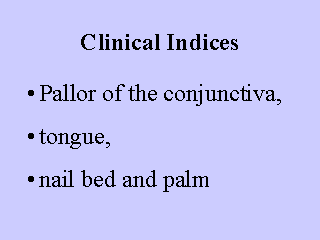|
|
|
|
front |1 |2 |3 |4 |5 |6 |7 |8 |9 |10 |11 |12 |13 |14 |15 |16 |17 |18 |19 |20 |21 |22 |23 |24 |25 |26 |27 |28 |29 |30 |31 |32 |review |
 |
Transferrin Saturation: corresponds to plasma iron divided
by plasma total iron-binding capacity X 100. Percentages below
16% in adults and children and below 12% in infants suggest insufficient
iron delivery to the hematopoietic tissues. Serum Transferrin receptors: Serum transferrin receptors reflect the number of receptors in immature red blood cells and thus the level of erythropoiesis. It is unaffected by infection or inflammation what makes Serum Transferrin receptors concentration be an accurate index of Iron nutrition status. Erythrocyte protoporphyrin: protoporphyrin combines with iron to form heme. Under ID conditions, the lack of iron determines an increase in erythrocyte protoporphyrin, which can not combined with Iron. Increased values of erythrocyte protoporphyrin indicate impaired erythropoyesis due to iron deficiency. Values greater than 100 ug/dl and 120 ug/dl have been used as cutoff points Pallor of the conjunctiva, tongue, nail bed and palm can be used as clinical indices of ID what is due to the low hemoglobin concentration in areas with high vascularization. Even when they are easily and inexpensively obtained, subjectivity is the main problem of clinical indicators. |
|
|
|
|
front |1 |2 |3 |4 |5 |6 |7 |8 |9 |10 |11 |12 |13 |14 |15 |16 |17 |18 |19 |20 |21 |22 |23 |24 |25 |26 |27 |28 |29 |30 |31 |32 |review |